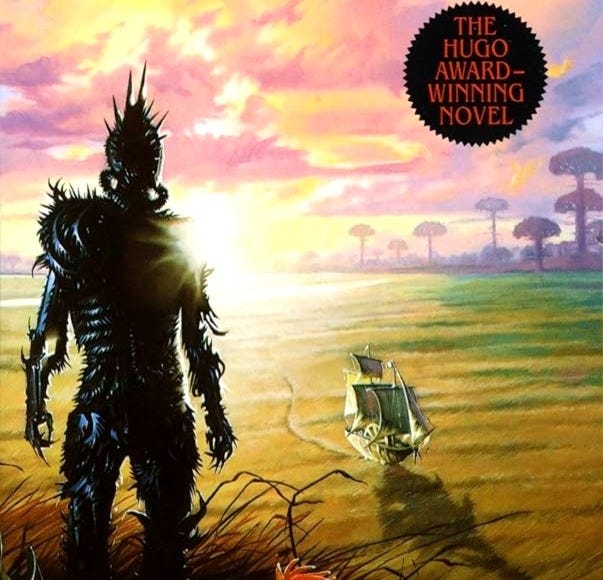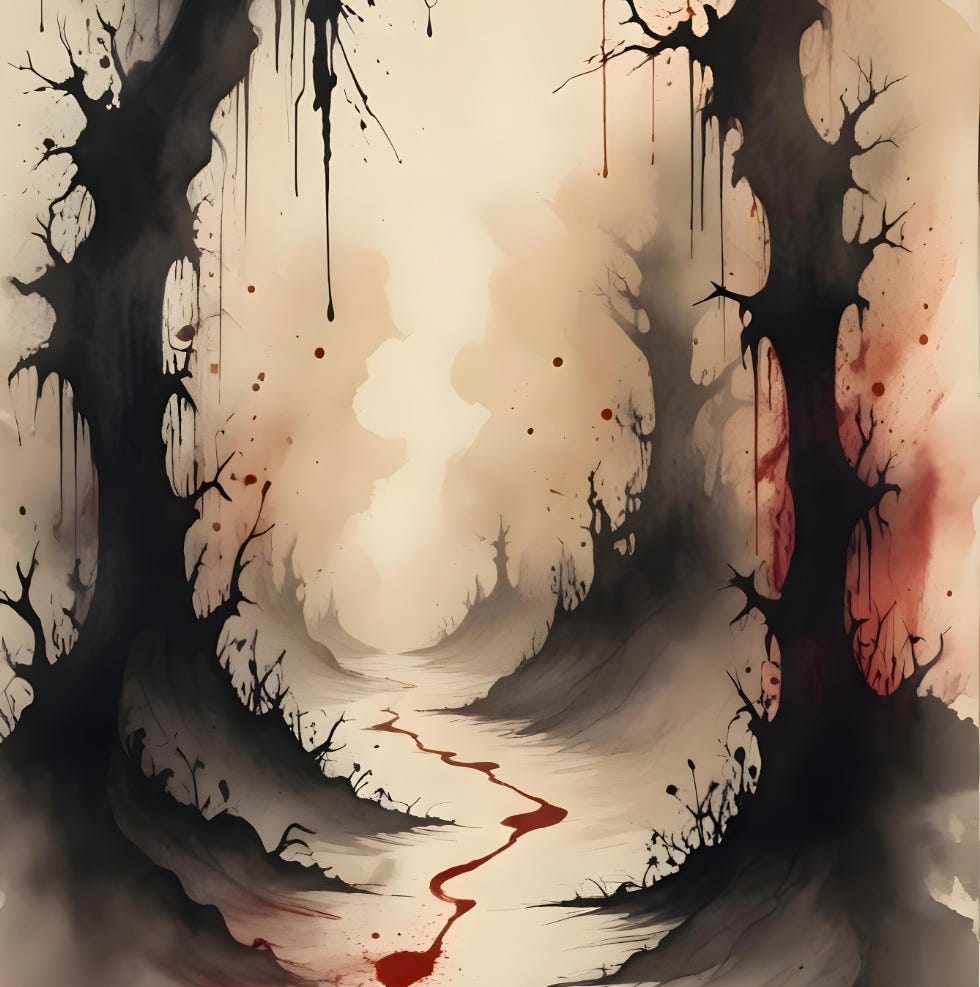Recently I’ve been reading about the classic science fiction series: the Hyperion Cantos by Dan Simmons. The first book Hyperion published in 1989 is my favorite SF book and indeed it is one the best books I’ve ever read. The follow-up to the Hugo Award-winning masterpiece The Fall of Hyperion is right up there among the best SF novels, and it is in my humble opinion one of the best works of military fiction.
Needless to say, I love the Hyperion universe. The vast, complex, and intricately detailed story that spans two duologies is rich in world-building, filled with complex characters and astonishing imagery, imbued religious symbolism, and succeeds as a commentary on the (destructive) evolution of technology. It is also a tale that elevates the captivating potential of poetry whilst exploring the beauty and danger of human passions whilst shedding light on the power of darkness.
In addition to telling a damn good yarn, the books that make up the Cantos, particularly the first two, succeed in evoking a range of emotions in the reader: from hope, anticipation, curiosity, awe, and excitement to fear, horror and abhorrence. The alternating styles of each of the six tales and how the world and the characters are fleshed out in stories that explore the depths of human suffering is a novelty in SF that remains unmatched to this day.
However, in my perusal of reviews, commentaries, and criticisms I have come to notice a pattern. And it is by no means a straightforward one. For starters, much of the discussions taking place, on online platforms like Reddit where Hyperion’s themes, plot line and character motivations are explored, and analysis of the deeper narratives and technology pervade, it is unmistakable to not overlook a visibly masculine tone.
For example, discussions on the competing motivations of elements within the TechnoCore and what it portends for the events that take place in the far future will only animate the concerns of a true Hyperion fan. The reason why the Shrike impales its unfortunate victims on the Tree of Pain for (possibly) an eternity of suffering can only deciphered by someone who has read the books at least twice, and/or who has followed supporting commentaries elsewhere. This now brings us to the main subject of this post: the reason why women, for the most part, are not likely to enjoy, and possibly even dislike Hyperion.
This is a big statement. how can I possibly know what one-half of the human species thinks about a bestselling SF novel, published over three decades ago? My answer is that as a student of the genre, as a writer who values great writing, and as a person with a particular set of preferences in terms of what I value in works of fiction, SF or otherwise, Hyperion just about nails it. Critically in a way that resonates with the male psyche.
However, as I will argue in this post, the pro-male sensibility is less likely to, and in many ways is unlikely to resonate with female audiences. A bit like why females connect with romance novels, in the same way young men gravitate towards the erotic.
Sanitized Fiction
I don’t like Disney Star Wars. The type of media that Lucasfilm has produced since its acquisition by the Mouse company sometime in 2012 has been utterly distasteful. Much has been said on this topic. The problems with Disney Star Wars, particularly since The Last Jedi (2017) have given rise to an entire subculture online, with content creators from various walks of life entering the space providing their opinions-and in the process building an audience and making a living-with Star Wars-related content.
The reader can find a more detailed take on my issues with Disney Star Wars here: The Mandalorian and the Anti-Humanism of Star Wars. For now, let me quickly summarize what’s wrong with the Star Wars franchise in the post-Lucas era, and what makes it unappealing to its key audience: Western, hot-blooded heterosexual males in search of adventure and escapism; and how this connects with the underlying appeal of Hyperion.
When Women Lead the Creative Department Sex Suffers
At this point, some of the readers would be aware of the long overdue take-down of the reigning inquisitor of Lucasfilm, Kathleen Kennedy by a mainstream outlet. I’m of course referring to the South Park episode where the filmmaking philosophy of the current president of Lucasfilm was laid out as follows: “Put a chick in it! Make her lame and gay” (1).
The idea that the only input Ms Kennedy has ever brought to Lucasfilm was the insistence on female characters to take up leading, secondary and supporting roles in various Star Wars media is well known. A decision point that has effectively led to the marginalization of traditional male characters. Disney Star Wars has showcased a clear pattern of anti-male bias. From the regression of Hans Solo in The Force Awakens, the humiliation of Luke Skywalker in The Last Jedi, the weakening of Obi-Wan Kenobi in the TV show of the same name, and the demystification of Boba Fett in a terrible bore of a show where much of his agency is eaten by the female supporting character. I can go on.
Now what is lacking in many of these criticisms of modern Lucasfilm is the purposeful shift away from artistic decisions that cater to, in simple terms “the male-gaze”. This in turn reflects a deeper problem: and that is the antipathy of Kathleen Kennedy-led Star Wars towards heterosexual sensibilities. This is another point I’ve engaged in detail in my essay: The Problem with ‘Strong Female Characters. The whole women’s empowerment movement at a deeper level is characterized and driven by two factors: menopause and lesbianism. Speaking of the latter, I’m not talking about the sensationalized male-fantasy version of it, but rather the male-allergic kind.
When one looks at what Star Wars has become, a franchise where the bad guys are never really threatening, the females are almost always in control, the male leads are invariably portrayed as weak, powerless eunuchs who need the women to help them out and are never able or willing to express any degree of sexual interest let alone manage a romantic conquest. And this is before we get to the subject of violence and gore. Which are virtually non-existent following the franchise’s purchase by a studio that is known for its theme parks and kids' toys.
Returning to Hyperion (1989), Dan Simmons’s masterwork represents the very antithesis of what Disney Star Wars stands for. It is a book that is filled with characters, stories, events, imagery and themes that showcase the best and worst that humanity, along with forces greater than man, has to offer. This takes us to the main point of this essay: why women don’t like Hyperion.
Hyperion is a Science Fiction for Men
There is some debate within the literary and artistic world on whether Star Wars qualifies as true science fiction. My take on it, in relation to Hyperion is that it is not. However, what is beyond dispute is that Hyperion is as good a science fiction book as any, winning the Hugo and Locus Awards for best novel, along with the follow-up novels in the series going on to win many accolades. Now what distinguishes Hyperion from many of the run-of-the-mill sci-fi romps is its seriousness.
Hyperion is dark. Very dark. It is atmospherically foreboding. With an aura of hopelessness pervading the entire world. Despite the amazing ideas, concepts and grand speculations on future history that it contains, Hyperion presents a world defined by dread and despair. This is one of the major problems for many female readers. This is not a world filled with bubbly characters and joyous themes. Rather it is a world where complex characters carry with them the scars of pain and heartache, where the hope of faith has diminished and the good guys are left to fight it out in a galaxy ruled by the unscrupulous Hegemony, on the cusp of war with an unknown enemy. And above all lingers the unknowable nightmare that is the Shrike.
The sheer degree of violence, sorrow and barbarity that the characters are subjected to is arguably the most profound I’ve ever encountered in literature. The fate of Father Paul Duré is one of the most harrowing tales one could imagine. As a man of faith, it provided me with one of the most believable glimpses into what Hell could be like.
Then there is the sex. And Hyperion has a lot of it. The idea that sex can be violence, a trope prevalent in certain radical feminist literature, is taken to a real and sickening extreme in this book. Having read a few other works by Dan Simmons I can say the author does have a penchant for the dark side of human intimacy. Thus it is understandable why women, unlike men, are likely to feel squeamish about this book. But again, therein lies its appeal… To men.
But this does not mean Dan Simmons is a sexist. The story is not lacking in, to use the expression ‘strong female characters’: as the women are portrayed in a wholesome and relatable way. Brawne Lamia’s story is one of my favorite in the book and is arguably the only (written) cyberpunk story that I’ve enjoyed to date.
Whilst Lamia is strong and capable, she is also feminine and likable. And true to her womanhood she finds love and companionship, with her connection to the Keats Cybrid becoming integral to the story. Whilst a fighter, she is by no “I know how to run without you holding my hand” Mary Sue (2). And this is what makes her, the story, and the world of Hyperion so appealing... To men.
Taking a step back, here’s a little pointer for male moviegoers and readers who are invested in SF. If the story or movie in question involves one or more prominent female characters who in the course of the runtime do NOT find themselves in a sexy, racy or horny position; either by themselves or involving another male or a feminine (non-lesbian) female character, then it is a good bet the film or story is not meant for you. For strong, masculine men with agency and purpose wish to see young, attractive women who desire to be valued and sought for their beauty and sexuality.
Sexual Escapades are a Male Fantasy – Adhere to It
Of the negative reviews of Hyperion by female reviewers that I’ve encountered online, one of the glaring features has been the inability of the said readers to actually finish the book. The readers for a variety of reasons were so turned off by the contents of the story, that they simply couldn’t finish it. One reviewer admitted to the unease and eventually disgust she felt towards the violence and sex it contained (3). Again, a lot of it is quite graphic, but I don’t know, maybe this makes me a sadist, but those were parts that I found to be intriguing… As a man.
‘The Soldier’s Tale’, the second story in Hyperion, involves a number of passionate encounters between the Colonel and this mysterious girl. The author presents these trysts in great detail. Possibly too much detail. That by certain standards is verging on the pornographic. However, it adds that element of titillation that stimulates the reader's mind and keeps him engaged in the story.
Interestingly, the erotic element that caters towards men is so lacking in modern SF and indeed in much of modern (Hollywood) entertainment is one explanation for this apparent antipathy among the female readership towards heterosexual sexuality. Women today have been fed a heavy diet of sexlessness on the big screen. Which partly reflects the growing prominence of women in the filmmaking arena. And let’s face it, sex is mainly a guy thing. We men seek, encourage, initiate and demand sex. Women, whilst the gatekeepers of intimacy, are never the drivers.
The dominance of feminism and its underlying anti-sex worldview as far as it pertains to heterosexual sensibilities, have eaten into the artistic medium. This is a much larger point that underpins many of the concerns that animate the counter-cultural voices of our time. The likes of Nerdrotic, Critical Drinker and Synthetic Man highlight the growing unease of many in the West towards the trajectory of modern popular culture. Since heterosexual men are not a vocal, politically organized group that concerns itself with activism and social change in the artistic arena and elsewhere, this problem continues.
Whilst the 2024 election brought the problem of “woke culture” front and center. The real problem, I would argue is a more specific one: It is the unease or antipathy towards male, heterosexual, masculine and by extension European (White) sensibilities in the artistic arena. Hyperion by Dan Simmons, written by a straight, White, American author with an anglicized name who lives along the Rockies, clearly fits the bill. For the wrong reasons for some, but absolutely the right reasons for others.
Conclusion: Feminized Fiction = A World Without Sex and Gore
For me, science fiction minus the violence, sex and horror is a knockoff. The technology, politics, religion, wars, conflict, love, betrayal combined with the terror, torture, cruelty, and eroticism set in a world with great stakes and awesome foes is what makes SF an artistic stimulant for men. The escapism and adventure that the fantasy genre embodies are grounded in a more believable world of rules and controls the author sets out: a distant future that is not beyond the potential capabilities of science and the current course of societal evolution to attain.
And when it comes to the sex and violence these stories contain, they represent a very real facet of human life. Humans are driven by the will to survive. Either as individuals, groups, communities, nations or empires. This inevitably leads to conflicts with the external other. The famous line from the post-apocalyptic SF video game Fallout: “War. War never changes” captures the essence of the speculative enterprise. Science fiction, however speculative the premises and extrapolations, must remain grounded in the realities that define human nature and the social dynamics of today and their evolution over time.
Science fiction, at its best, is not about envisioning futures that are totally alien or separate from the one we have today. It is about prognosticating the future whilst staying true to the social, cultural, economic, political, spiritual and technological realities of the present. Whatever utopian conception of the future these politically correct (feminized) writers and readers of our time have in mind, its realization ultimately hinges on the development of polities that are based on rules, norms, values, and systems and underlying it all, human nature, that governs the world today.
A world where human decisions are invariably driven by financial, relational, social and biological needs and wants. And the struggle to meet them produces inevitable conflicts. Conflicts that bring about the best and worst that humanity has to offer. Science fiction, unlike fantasy or even the supposedly more grounded romance genre in principle, must adhere to this framework.
Escapism whilst an integral component of SF, is not the defining feature. It is a subset that allows the reader to immerse himself into the shoes of a character who can do and experience unbelievable things but must yet face the challenges, hardships and disappointments of life.
Science fiction done correctly is about presenting contemporary reality and its possible evolution in a way that resembles our wildest dreams or nightmares, but yet remains believable, achievable and for that matter avoidable. If romance novels, the feminist-dominated popular culture of which modern Star Wars (and indeed much of modern entertainment) is a by-product, are anything to go by, what women want for this medium is not escapism and adventure, but normality, security and predictability.
References
Hollywoodreporter.com. (2024). Page Restricted. [online] Available at: https://www.hollywoodreporter.com/tv/tv-news/south-park-disney-kathleen-kennedy-gina-carano-1235632407/ [Accessed 29 Dec. 2024].
Wilson, K. (2016). Star Wars: 10 Funniest Moments in The Force Awakens. [online] ScreenRant. Available at: https://screenrant.com/star-wars-7-force-awakens-funniest-moments/ [Accessed 29 Dec. 2024].
[Sound Engraver (2023). Hyperion: Just Because It’s Famous Doesn’t Mean It’s Good. [online] YouTube. Available at:
[Accessed 29 Dec. 2024]. | Tiffany Russell (2023). Hyperion by Dan Simmons. That’s a nope from me. [online] YouTube. Available at:
[Accessed 29 Dec. 2024]].









